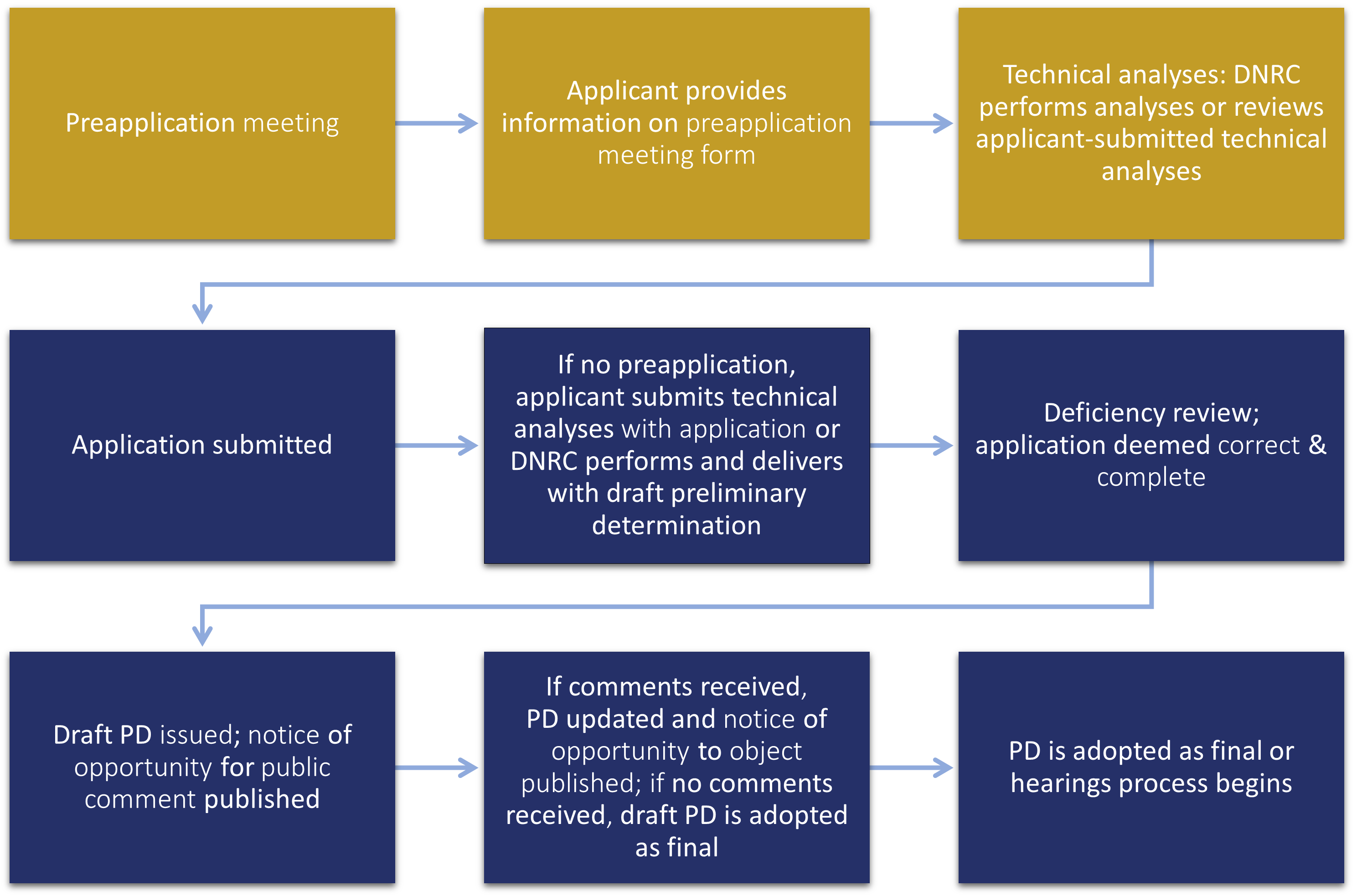Permit and Change Application Process Information
During the 2023 Legislative Session, the Montana Legislature passed HB 114, which went into effect on January 1, 2024. HB 114 made several significant changes to the water right permit and change application process, which the Department is implementing through the adoption, amendment, and repeal of administrative rules. This page provides some key details about the process changes.
Permit and Change Process Under HB 114

Key changes to the permit and change process under HB 114:
New Options for Applicants. Under the new procedure, there are multiple pathways available through the application review process. Most significantly, permit and change applicants can choose:
- whether to complete a preapplication meeting or not, and
- whether to have the Department conduct the technical analyses or supply their own technical analyses.
Benefits of the preapplication meeting. Perhaps the biggest advantage for applicants participating in the preapplication process is increased certainty. During the preapplication period, the Department either completes the necessary technical analyses or assesses the scientific credibility of applicant-provided technical analyses. This means that an applicant will be made aware of any issues with their technical analyses and have a chance to resolve those issues before submitting their application. By contrast, an applicant who supplied their own technical analyses and elected not to complete a preapplication meeting would not receive the Department's review of their technical analyses until issuance of the draft preliminary determination.
In addition to the confidence of knowing that the Department has performed or signed off on the technical analyses, applicants who elect the preapplication meeting also enjoy faster timelines and lower application fees.
Benefits of DNRC performing the technical analyses. All permit and change applications require technical analyses, detailed in the HB 114 administrative rules (See New Rule III). Under the new rules, the Department performs the technical analyses unless the applicant elects to provide their own. This is intended to save applicants the energy and money of hiring experts, while also increasing the consistency and efficiency of the Department’s determinations.
For applicants electing to provide their own technical analyses, the Department is making its pertinent standard practice documents, non-rescinded technical memos, and the Technical Analysis Guide accessible online so that applicants know how their analyses will be reviewed.
Changes to the Public Notice and Objection Process. The overhaul of the permit and change process impacts existing water rights holders, too. For applications filed on or after January 1, 2024,
- A 30-day public comment period will be held on the Department’s draft preliminary determination.
- If public comments are received, the Department will consider them and then notice the preliminary determination for objections.
- If no public comments pertinent to the relevant criteria are received, the draft preliminary determination is adopted as final.
The result: potentially impacted water users can voice concerns earlier in the process. DNRC will be able to consider and address public comments on decision documents prior to the formal hearings process. This leads to better decisions and reduces the costs for potential objectors.
To participate in the process, existing water users need notice about pending applications that may impact them. DNRC developed the new Water Rights Notification Tool (WRNT) as a fast, tailored supplement to traditional newspaper publication (newspaper publication will still occur for both public comment and objection periods). The WRNT generates email alerts – customizable by source type, basin, and county – when a permit or change application within a user’s selected parameters reaches key milestones.
Considerations During the Transition Period.
Applications will be processed using the statutes and rules in effect at the time of application receipt. This means that there will be period of time over the next year or more where some applications are being noticed for public comment and others are not, some applications are subject to faster timelines and others are not, etc.
- For an application received on or after January 1, 2024 to be eligible for the expedited timelines and reduced filing fee if a preapplication meeting occurs, the preapplication meeting must occur on or after January 1, 2024. This is because HB 114 designates a preapplication meeting as a formal process affiliated with completion of technical analyses, and the proposed rules include a form and fee associated with a preapplication meeting.
- If you had a preapplication meeting prior to January 1, 2024, and you want to submit your application on or after January 1, 2024 and have the expedited timelines and reduced filing fee apply, you may complete another preapplication meeting with the Department.
Do you have questions that aren’t answered here? Your regional office is ready to help. In addition, on January 4, 2024, staff from the New Appropriations Program, Water Sciences Bureau, and Regional Offices hosted a webinar about updates to the permit and change application process from the passage of HB 114. You can link to a recording and slides from the webinar below for an in-depth discussion on the new process.
